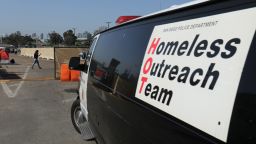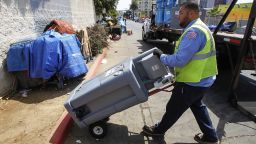Story highlights
600 cases, 19 deaths confirmed in California
Gov. Jerry Brown declared a state of emergency
As firefighters continue to battle blazes across the state of California, public health officials are dealing with another ongoing crisis: one of the largest person-to-person hepatitis A outbreaks in the country since the development of a vaccine, more than two decades ago.
An update provided Thursday by the California Department of Public Health (CDPH) raises the case count to 600. 395 people have been hospitalized and 19 have died since November 2016.
Last week, California governor Jerry Brown declared a statewide state of emergency, in an attempt to stop the spread of the virus. The proclamation permits CDPH to expedite the procurement of the hepatitis A vaccine. It also allows EMTs to administer the vaccine, outside of a clinical setting, to high-risk individuals – which include the homeless and illicit drug users.
“Vaccinating people at risk of exposure is the most effective tool we have to prevent the spread of hepatitis A infection during an outbreak,” said CDPH director Dr. Karen Smith, in a written statement.
San Diego, Santa Cruz and Los Angeles counties have officially declared local outbreaks, but CDPH said outbreak-associated cases have been confirmed in other parts of the state, as well. The agency said it has already distributed more than 80,000 doses of the hepatitis A vaccine.
“We have what is a pretty unprecedented outbreak, based on the number of cases we have so far,” CDPH deputy director for infectious diseases, Dr. Gil Chávez, told CNN. “Dating back to March, we have been taking this extremely seriously and have been working very closely with officials from the affected counties, as well as officials from the CDC.”
The answer to the question, “Why now?” remains elusive. Somehow, the highly contagious liver infection hepatitis A was introduced into the homeless community. Poor hygiene and lack of access to clean bathrooms exacerbate the risk of contracting the virus. According to the CDC, person-to-person transmission via the “fecal-oral route” – “ingestion of something that has been contaminated with the feces of an infected person” – is the most common way the virus spreads. It can also be transmitted through contaminated food or water.
Typically, fewer than 3,000 cases of hepatitis A are reported each year in the United States, according to the CDC. Many adults who become infected will exhibit symptoms after about a month of being exposed to the virus. Symptoms can include fever, fatigue, loss of appetite, nausea, vomiting and abdominal pain, and usually last less than two months. The majority of children who become infected will not exhibit any symptoms at all.
“One of the things that we’ve learned since March is that a lot of the usual ways to vaccinate communities don’t work very well with (the homeless) community,” Chávez said. “You cannot just say, ‘We’re holding a vaccination clinic at a certain place’ and expect that people are going to show up.”
Chávez said CDPH has been working closely with local health departments to get creative with homeless outreach.

“We have created ways in which we send teams of people – a nurse with a community worker – into the field, literally walking down riverbeds, embankments, going down under freeways and talking to people and asking them to be vaccinated,” Chávez said. “This community tends to have a distrust of government and (doesn’t want) to talk to you if you’re a government official. … Over time, we’ve come to realize that we’re making inroads and that more and more homeless individuals are agreeing to be vaccinated than when we first started.”
Local health departments in California act independently, Chávez said, so each municipality is dealing with the outbreak differently. In San Diego, the hardest hit county, there has been a coordinated effort to increase access to clean bathrooms. San Diego Public Health Services has also installed temporary sanitation stations throughout the city, particularly in areas with high homeless populations, and is washing city streets to reduce the amount of the virusin neighborhoods.

“One thing that is very interesting about the hepatitis A virus is that it actually survives in the environment for a long time, so unless you wash it away, it can linger for weeks,” Chávez said. “The more we can provide access to sanitation, the more that we can clean regularly and disinfect, the quicker we can get a handle on this.”
The majority of adults in California have not been inoculated, as the state only began recommending routine vaccination for children in 1999. The hepatitis A vaccine is more than 95% effective after a first dose and almost 100% effective after the second recommended dose. Once someone has recovered from the disease, they are immune to getting it again.
Follow CNN Health on Facebook and Twitter
“If you dissect the outbreak into the two main counties – Santa Cruz and San Diego – we can say comfortably that Santa Cruz has certainly turned the tide and they are on a downward trend,” Chávez said. “In San Diego, we’ve been watching very closely and for the past several weeks, the number of weekly cases has been pretty stable, which is good news.”
Chávez said he wants Californians to know that this outbreak, while serious, is not a widespread problem.
“It’s really focused on a specific part of the state, in a very specific community,” he said. “For the general population of the state, there is no increased risk, so people don’t need to worry.”





